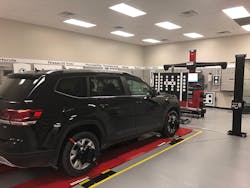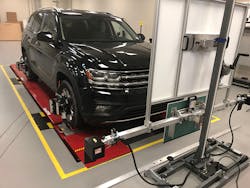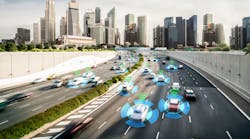The need for scanning continues to grow, and fortunately, the collision repair industry is accepting the need and requirement to perform scans. Scans at the beginning of the repair help improve estimating and decrease liability; of course, more importantly, after all the work has been completed, the completion scan is performed. The completion scan has become the final quality inspection point for many repairers. Identifying that all parts and pieces are equipped and functioning correctly, all codes are cleared, and the virtual road map of the repairs has been deleted. As great as it is that the industry is checking the scanning box, the electronic portion of the repair may not be complete after the completion scan.
Consider it this way. You’ve broken a major bone. The first step the doctor is going to take is an X-ray. This will help them assess the damage and develop a plan to correct the break. Once the plan is established, verified with specialists, you will be wheeled off to the operating room. Depending on the procedure, a few hours later you’ll be out and in a cast. After weeks of healing the cast will be removed and you’ll be ready for the next step. Eventually you will be back to normal but first there will be one more x-ray to determine that everything has structurally healed. Once the doctor has given the thumbs up on the structural healing a physical therapist will help in the painful process of regaining mobility, retraining your body how to move and regaining your strength. Once you’re back to fighting strength it is quite possible a final x-ray will be required before a clean bill of health is issued. Scan, repair, scan, rehabilitate and another scan. Repairing a vehicle has become very similar. Scan at the time of the estimate, repair the vehicle, scan to ensure the repairs are correct, calibrations and a final scan. After those final scans and calibration only then can a final clean bill of health be issued.
Performing a scan is relatively straight forward. Aftermarket tools provide quick, inexpensive solution to reading codes and looking at live data. Having a trained mechanic review the data is critical so that nothing is overlooked. Using a sublet vendor to perform the scan can allow for less experienced technicians to oversee the scans. The sublet vendor knows what data to review and can be a better guide through the multiple streams of data. The best sublet vendors also utilize OEM tools to ensure that every module is properly scanned with the most recent software from the specific vehicle manufacture for that specific model. Calibration can be tricky. Much like an X-ray doesn’t tell you what your brain and muscles have forgotten, a scan doesn’t necessarily reveal what the computer and sensors have forgotten or have had misaligned during the repairs. Just like the trained professionals who aid in physical therapy and rehabilitation, collision repairers must know when and what calibration is required. Again, scanning helps tell what is obviously wrong and has very easy clear-cut need but calibration is not as easy.
How do you know when calibration is required? The saying “you don’t know what you don’t know” has never been truer in vehicle repair. There is only one way to know and that is research. Research what systems are on the vehicle and what systems were/will be disturbed during the repair. The key to this is that touching or working with the physical components is not the only reason why those components may need calibrating. Removing a bumper, replacing a windshield, disconnecting a battery, performing a wheel alignment, and even the collision itself are all grounds for calibration. Reviewing position statements and repair procedures is the only way to know when calibrations may be required. Most calibration requirements cannot be identified with a scan or seen by a malfunction light on the dash. There is simply not a code generated with a misaligned sensor or camera.
When it comes to calibration the list of equipment and training jumps tenfold over scanning requirements. The simplest of calibrations still require lengthy repair procedures to understand their proper execution. The simplest calibrations require just an OEM scan tool, while more complex calibrations may require alignment machines, calibration targets, specific floor mats, and large open areas. While the tools and equipment required to perform the calibration may be available the physical square feet required may not be for most collision repair centers. An average size stall in a body shop is 12x20 feet, or 240 square feet. A calibration stall may require a space of 25x40 feet, 1,000 square feet or larger. This puts a simple calibration stall at greater than 10 percent of the average sized shop. This sort of room simply doesn’t exist.
Calibration of minor systems has been performed for years now. Resetting the anti-pinch on auto closing windows is a form of calibration. Performing a zero-point calibration for the weight sensors in seats is a slightly more advanced and infinitely more important form of a calibration. These types of calibration are needed on the vast majority of cars repaired every day. These calibrations are typically done during the final scan and are usually lumped in and executed simultaneously. The calibrations that are really going to weigh down collision repairs are those of the advanced driver assistance systems. These ADAS calibrations are endlessly advanced and complicated, and those ADAS calibrations are what requires the giant spaces, costly targets, and what feels like endless amounts of labor.
Scanning was not the first big hurdle in the collision industry. We have fought difficult paint systems, the advent of high strength steels, aluminum and airbags. Airbags used to be a difficult scary proposition that many shops refused to tackle. As time progressed shops got more familiar with dealing with airbags and it is now expected for a shop to be able to handle them. The training is abundant, the understanding is common and charging for them is also fair and easily negotiated. Scanning has quickly gone a similar route. Proper fair compensation is now commonly reached, a general understanding is becoming the norm, and more shops are completing the task each day. ADAS Calibration is yet another hurdle in collision repair but it will be the biggest this industry has ever faced. While many were worried about the cost, equipment and cycle time of airbags or scanning they are insignificant in comparison to calibration. ADAS calibrations are so much more than anything we have faced before.
Vehicle manufacturers, dealerships, insurance companies and body shops have a tremendous hurdle on our hands with the challenges of proper calibration of ADAS systems. To start most ADAS calibration require a thrust angle alignment to be performed, proper weight in the vehicle (Fuel, passenger compartment empty, weight to simulate passengers, etc.) next the vehicles must be parked on a flat surface, with the required amount of empty space around the vehicle, and lastly properly placed targets around the vehicle. This includes calibration for all cameras (forward facing, 360 degree, etc.), blind spot monitors, Lidar, Radar, Sonar, and any other sensor that you can think of. Once the vehicle is ready and the surrounding area is prepped an OEM scan tool is used to place the vehicle’s computers into the proper learning mode so the calibration can occur. The calibrations may require multiple steps, moving the targets, and a very specific road test to finalize the full calibration process. After all steps have been followed then a completion test drive has to be performed.
The worse part about these calibrations is the inability to truly know when it has to be done and worse yet when it has been done correctly. When an engine has an issue, it creates a fault code, when a sensor is unplugged it creates a fault code, even when a tail light has been disconnected a fault code is created and stored. When a camera is out of alignment or a blind spot monitor is tweaked, there is no fault code, there is no warning on the dash, and with out proper knowledge of the way the system is supposed to function it may be impossible to know that it isn’t functioning correctly. All that said if it isn’t functioning correctly the customer will find out, and the hope is that they find out in a way that doesn’t cause risk of injury or death. This is why it is imperative to know when a calibration is required, and how the systems are supposed to perform so a complete and extensive completion test drive can be performed. Research the owner’s manual, call dealerships, or visit mycardoeswhat.com to fully understand each ADAS system. Once understood drive the vehicle in such a way that those systems are checked for proper performance.
Performing ADAS calibration will likely not be done by most repair centers. Repair centers simply will not have the space, training and equipment required. While some repair centers may have the desire to get the training and equipment the space requirement are simply a hurdle that most will not be able to overcome. Subletting ADAS calibration may be the only option for many repairers. This sounds easy, but the liability for the proper calibration does not go away by having someone else perform it. It also does not speed the process or reduce the cost. Dealerships are struggling to understand how these calibrations must be done, they lack training, the service drives lack the space, and since they are independently owned the desire to perform the calibrations may not be there either. If subletting is the only option it may best to provide the OEM repair procedures and have a good discussion with the service manager to ensure that they understand what is required. Once the calibration has been completed an extensive test drive with the vehicle to ensure that the calibration was performed correctly is imperative.
If you don’t think this is a real problem, think again! By 2022 automakers have agreed to make automated emergency braking standard. That means by 2022 every single new car produced may require some form of calibration after a front-end impact or windshield removal. Looking at most new models this is already standard or at least an option and has been for a couple of years now. This isn’t technology limited to luxury cars, this is technology already installed in the most common sedans, trucks and SUVs. Reviewing industry trends shows you that vehicle model years that have this technology could make up 30-40% of our repairable vehicles in less than three years. It currently makes up nearly 10%. As much time as calibrations take today that time will only go up as more and more cars require it. Back logs at dealerships will grow, increasing costs and increasing delays, two things that makes all parties involved cringe.
Compared to other hurdles, this is a huge hurdle not just for the cost and time but for the increased liability. Scanning arguably has been the first large and costly item that has to be done on nearly 100 percent of the cars we repair. It has been a massive adjustment for repairs and payers. ADAS calibrations will be timelier, more expensive and will affect a very large percentage of cars repaired. Improper calibration may cause the vehicle to fail to prevent a crash, or worse yet cause a crash! This is a hurdle not just for repairers and payers, this is a problem for every supplier, manufacturer and customer. Finding solutions will have to be a team effort!



